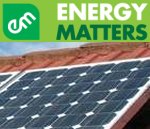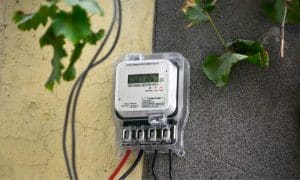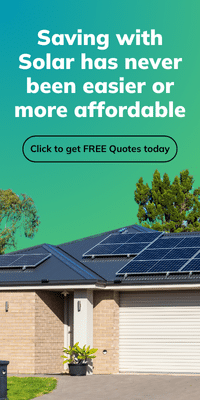MEDIA RELEASE 27 March 2013: Australians feeling the pinch from high electricity prices have an economical alternative, and if every suitable rooftop in Australia hosted solar power systems, the amount of energy generated would supply more than 134.8% of the country’s residential electricity needs.
Not only would the installation of solar on every roof be a boon for jobs, the cost of the electricity being generated would be reduced to a mere 7 cents per kWh. This potential new pricing point is in total contrast to what Australians are currently paying; up to 40 cents per kilowatt-hour (kWh)1 in some parts of the country, which is predicted to continue climbing.
The conservative figures were calculated by solar energy provider Energy Matters, utilising recent government data in order to prove a point; that solar power is a viable solution to Australia’s energy challenges and would dramatically change our nation’s reliance on expensive, polluting fossil fuels to generate electricity.
While the total cost of the installation would represent 8% of Australia’s yearly GDP, the actual cost would be 0.4% per year as the figure would be amortised over 20 years. Consider this; Australia spends over $15 billion each year on electricity, that’s 1% of it GDP.
“This could easily become a reality and the positive impact on our lives would be immediate and long-lasting, “commented Nick Brass of Energy Matters. “Our vision is not too dissimilar to Bill Gates’, who predicted every household would have a computer. People at first scoffed at this vision, but the advent of the affordable personal computer changed the world. Energy Matters’ grand plan is to help convert every suitable rooftop in Australia into a solar power station.”
Energy Matters’ figures are extremely conservative. While the company’s calculations show solar can supply 134% of Australia’s residential needs, the actual figure would be much higher.
The knock on effect would be massive; energy prices and CO2 emissions would be reduced dramatically. The initial costs of installation would be steep, but the yearly savings would soon pay off this investment.
Energy Matters has determined there is just shy of 400 sq. kms of available roof space on residential roof tops in Australia that could accommodate solar panels. That’s the size of inner Melbourne.
With the company’s conservative calculations, each one of the suitable houses could theoretically hold an 8kW solar power system; 32 panels per rooftop. The cost for each system at the current market rate would be less than $14,000.
“The idea is for the eligible houses to produce more electricity than they need with the excess supply fed back into the grid in order to power Australia’s residential and non-residential needs,” continued Mr. Brass. “Further calculations we performed indicate the amount of electricity generated would supply 38.8% of Australia’s total electricity requirements (inclusive of all residential, industry, commercial services, metal production and mining).”
These houses with 8kW solar ‘power stations’ on their rooftops would generate 36kWh per day. With the average household currently consuming 18kWh per day, the resultant electricity would earn the household between $2100 and $3,200 per year depending on how much electricity they consume themselves. This would mean the system would be paid off in between 4 and 6 years. Once paid off, the solar power system would create free electricity thanks to the sun. A government-sponsored rollout of solar power systems would drive down the cost even further.
What would this mean for Australia’s current electricity production facilities? “There would be almost no need for base load power stations on a sunny day,” said Nick Brass. “Australia could close down most of its coal-driven power stations overnight, except for those in heavy industrial areas. Under-utilised gas fired peaking plants, which are already in existence, would be called upon to generate Australia’s night time and cloudy day electricity needs. Shutting down Australia’s coal power stations alone would mean our emissions targets would be met almost immediately.
“A national rollout would be a mammoth task and would involve many companies coming together for the good of the country. Energy Matters is in a very fortunate position in that we not only have a national presence, our solar power systems are built for Australia’s harsh environment,” said Mr. Brass.
“We have relationships with the best suppliers in the world and when we feel components don’t meet the standards needed for Australian conditions, we’ve manufactured our own. Our Australian designed and manufactured SunLock mounting system is a prime example. This mounting system is the toughest in the business and can even withstand cyclonic conditions,” concluded Nick Brass.
INTERVIEWS WITH NICK BRASS
Finbar Corrall on 02 9365 0007 or 0412 792 674
Appendix – full references available on request
|
Criteria |
Assumption |
Reference |
Notes |
| All dwellings in Australia | 9,140,231 | Census 2011 – ABS | There are 9.4 mil houses in Australia |
| # of Dwellings | 7,637,581 | Department of Infrastructure and transport | Of the 9.4 mil houses in Australia, 7.6m that constructed in a way that would be appropriate for solar |
| Eligible Roof Tops | 84% | 7.6m is 84% of 9.14m | |
| Average floor Size (m2) | 150 | Australian Bureau of Statistics | This is a conservative figure considering the ave. new home represents 220m2+ of floor space. Homes built before 1970’s were on average 140m2. |
| Eligible Area (roof space) | 34% | Assuming 70% of homes are single storey, 10% of available areas is inappropriate for solar, 10% have roofs too steep for solar, 10% have chimneys and obstruct ructions, 25% of roof areas is facing due south and 10% of the edge zone around the roof borders needs to be kept clear for access etc | |
| Total SQM of Private roof top available in Australia | 394,617,580 sq. m | 394 Sq. Kms | In total we get just shy of 400sq. kms of available roof space on residential roof tops for solar |
| Size of Inner Melbourne | 450 sq. kms | Australian Bureau of Statistics | Inner Melbourne as a sum of Statistical areas level 4 of Inner Melbourne, Melbourne Inner South and Melbourne Inner East. |
| Average size of Solar 250W Panel | 1.60 sq. m | Conservative figure a 250W panel is 1.65m2 | |
| Number of panels we can fit | 246,635,988 | Based on the size of an REC 250W standard panel | Available area divided by 1.6m2 per panel |
| STC rating of kW per panel | 0.25 | A 250W panel will deliver 0.25kW of output at standard test conditions (STC) which is 25 degrees at sea level conditions | |
| Solar Per m2 per day (kW per m2) | 4.50 | ABS & Bureau of Meteorology | Available energy per square meter in Australia based on sunlight available for each capital city and correlated against head of population (see kW per day tab) |
| Amount of kWh produced per day by the panels (combined) | 277,558,883 | -Number of Panels as per previous calculation
-Power Rating as per STC manufacturer label -Weighted average of sunlight irradiance in Australia based on Bureau of Meteorology data. |
number of panels x rating of each panel x available sunlight per sq. m |
| Power Derrating (efficiency reduction) | 80% | Heat, Dust, Angle, degradation etc | Industry standard is to de-rate at 90%. This takes into account high heat, degradation over time (note 80% warranty on panel output in 25 years is standard). However, as this calculation is focused on 1 year of solar production, degradation should not be considered to be more than 1% of losses |
| Derrated Production per Day | 222,047,106 | Taking derating production into account the resulted production equates to this figure | |
| # of days | 365 | days in year (excluding leap years) | |
| Yearly Production in GWh | 81,047 | A conservative assumption of solar energy production in 1 year | |
| Theoretical kW arriving into available area | 648,378 | ||
| Efficiency of Solar Technology (250W used) | 12.50% | Proving the conservativeness of our calculations this shows 12.5% efficient compared to the 250W REC module (see link above) which is rated as 15.1 efficient | |
| Average Space for solar per House in Australia | 51.67 sq. meters | No of eligible dwellings divided by total available area for solar | |
| Panels able to be fit | 32 | 32 x 1.6m sq. panels can fit in 51.67 sq. m | |
| Average System size that a House can Hold | 8 kW system | kW per household is achievable based on roof space available after above assumptions are taken into account | |
| Australian Total Electricity Consumption (GW) | 208,944 | Bureau of Resources Energy and Tourism | |
| Australian Residential Electricity Consumption (GW) | 60,139 | Bureau of Resources Energy and Tourism | |
| Total cost of residential electricity consumption | 15,034,722,223 | ||
| Total cost of residential electricity consumption (compared to GDP) | 1.0% | ||
| Average Household consumption per day (kw) | 18 | Based on total electricity consumed and no of Australian dwellings | |
| Production with solar over Total Consumption | 38.8% | ||
| Production with solar over Residential Consumption | 134.8% | ||
| Total Power Plant Capacity (GW) | 43 | See Calculations | List of all Australian power generators |
| Full capacity production per year (GWh) | 376 | ||
| Capacity Factor | 14709% | See Formula | Based on total residential electricity consumption, against total available electricity generation capacity |
| Share of renewable electricity | 8% | 2008 | |
| Number of solar panels | 246,635,988 | The area available divided by the area of a single panel | |
| System size (kW) | 61,658,997 | The number of panels multiplied by kW rating of each (.25) | |
| System size (GW) | 62 | ||
| System cost ($AU) | $ 110,986,194,490 | The system size multiplied by $1.8/watt – price installed after STCs | |
| Australia’s GDP | $1.451B | Australia’s GDP 1.45billion | |
| % of GDP | 8% | As a percentage of a 2 trillion dollar economy | |
| cost per kwh generated | $ 0.07 | cost of producing the electricity assuming 20 years of production without discounting any further |
















































